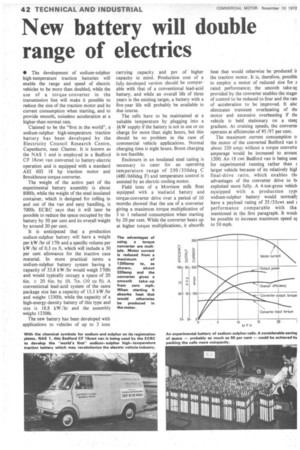New battery will double range of electrics
Page 44

If you've noticed an error in this article please click here to report it so we can fix it.
• The development of sodium-sulphur high-temperature traction batteries will enable the range and speed of electric vehicles to be more than doubled, while the use of a torque converter in the transmission line will make it possible to reduce the size of the traction motor and its current consumption when starting, and to provide smooth, noiseless acceleration at a higher-than-normal rate.
Claimed to be the "first in the world", a sodium-sulphur high-temperature traction battery has been developed by the Electricity Council Research Centre, Capenhurst, near Chester. It is known as the NAS 1 and is employed in a Bedford CF 18cwt van converted to battery-electric operation and is equipped with a standard AEI 602 18 hp traction motor and Brockhouse torque converter.
The weight of the active part of the experimental battery assembly is about 8001b, while the weight of the steel insulated container, which is designed for rolling in and out of the van and easy handling, is 700lb. ECRC says that it will later be possible to reduce the space occupied by the battery by 50 per cent and its overall weight by around 20 per cent.
It is anticipated that a production sodium-sulphur battery will have a weight per kW /hr of 171b and a specific volume per kW /hr of 0.3 cu ft, which will include a 30 per cent allowance for the inactive case material. In more practical terms a sodium-sulphur battery system having a capacity of 33.8 kW /hr would weigh 5701b and would typically occupy a space of 2ft 6in. x 2ft 6in. by lft. 7in. (10 cu ft). A conventional lead-acid system of the same package size has a capacity of 13.3 kW /hr and weighs 13301b, while the capacity of a high-energy-density battery of this type and size is 18.8 kW /hr and the assembly weighs 13301b.
The new battery has been developed with applications to vehicles of up to 3 tons carrying capacity and psv of higher capacity in mind. Production cost of a fully developed version should be comparable with that of a conventional lead-acid battery, and while an overall life of three years is the existing target, a battery with a five-year life will probably be available in due course.
The cells have to be maintained at a suitable temperature by plugging into a ikW supply if the battery is not in use or on charge for more than eight hours, but this should be no problem in the case of commercial vehicle applications. Normal charging time is eight hours. Boost charging is not feasible.
Enclosure in an insulated steel casing is necessary to cater for an operating temperature range of 250/350deg C (480 /660deg F) and temperature control is assisted by an electric cooling motor.
Field tests of a Morrison milk float equipped with a lead-acid battery and torque-converter drive over a period of 10 months showed that the use of a converter giving a maximum torque multiplication of 3 to 1 reduced consumption when starting by 20 per cent. While the converter heats up at higher torque multiplications, it absores heat that would otherwise be produced it the traction motor. It is, therefore, possible to employ a motor of reduced size for rated performance; the smooth take-ur provided by the converter enables the stage: of control to be reduced to four and the rate of acceleration to be improved. It alsc eliminates transient overheating of the motor and excessive overheating if th( vehicle is held stationary on a steel gradient. At cruising speeds, the convertel operates at efficiencies of R5 /97 per cent.
The maximum current consumption o the motor of the converted Bedford van about 320 amp; without a torque converte amperage would be increased to arounc 1200. An 18 cwt Bedford van is being usec for experimental running rather than larger vehicle because of its relatively hie final-drive ratio, which enables tht advantages of the converter drive to bi exploited more fully. A 4-ton-gross vehicit equipped with a production typt sodium-sulphur battery would normalll have a payload rating of 25 /35cwt and performance comparable with tha mentioned in the first paragraph. It woul( be possible to increase maximum speed m to 50 mph.




































































































































